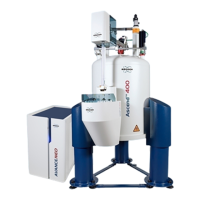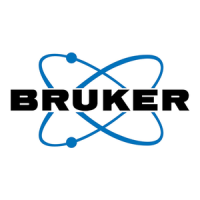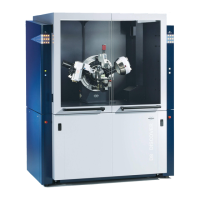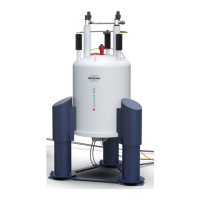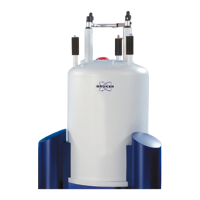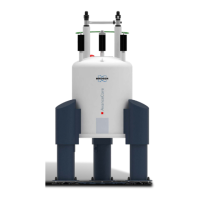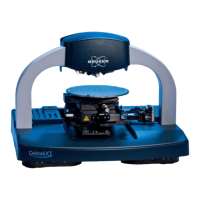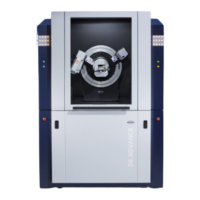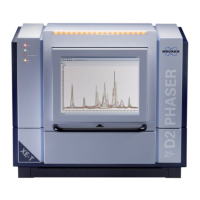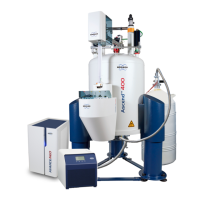
Do you have a question about the Bruker AVANCE NEO and is the answer not in the manual?
| Magnet Type | Superconducting |
|---|---|
| Software | TopSpin |
| Console Type | AVANCE NEO |
| Lock Channel | Yes |
| Gradient System | Optional |
| Number of Channels | Up to 16 |
| Field Strength | 0.5 to 1.2 GHz |
| Nucleus | Broadband multinuclear capability |
| Temperature Range | -100 °C to +150 °C |
| Dimensions | Varies by configuration |
| Weight | Varies by configuration |
| RF Channels | Up to 4 |
| Digital Receivers | Multiple, typically 2 or more |
| Cooling System | Liquid helium and nitrogen |
| Probe Types | Various |
Explains the SI unit Tesla (mT) and conversion factors for magnetic field strength.
Discusses the three-dimensional nature of the magnetic field and its effects on equipment.
Defines the area within the 5 Gauss (0.5 mT) field line and restrictions for individuals with implants.
Defines the zone confined to the magnet room and precautions for ferromagnetic objects.
Details safety lines based on EU directive for magnetic flux density of static fields.
Covers international standards and guidelines for static magnetic fields and ELVs.
Provides safety notices for transporting and rigging AVANCE NEO systems.
Discusses ventilation requirements for NMR systems using cryogens, including regular and emergency ventilation.
Explains properties of cryogens and safe handling practices for liquid helium and nitrogen.
Advises on precautions for potential earthquakes and checking local regulations.
Identifies hazards from nearby construction and their potential impact on the magnet system.
Highlights the need to fulfill country-specific safety regulations for NMR systems.
Emphasizes defining and communicating emergency plans for system operation.
Describes the superconducting magnet as the core NMR system component.
Lists and describes the main parts of the console and monitoring units.
Details the CryoProbe accessory for increased signal-to-noise ratio.
Introduces the CryoProbe Prodigy for sensitivity enhancement using liquid nitrogen.
Highlights additional accessories like SampleCase and SampleXpress.
Factors to consider for offloading the magnet and console during delivery.
Checks required for transporting the system from the access point to the lab.
Provides dimensions and weights for magnets, stands, and accessories.
Lists necessary rigging equipment for magnet delivery and installation.
Illustrates ceiling height requirements for helium transfer line insertion.
Lists minimum ceiling height requirements for magnet operation and installation.
Displays horizontal fringe field distances for various magnet types.
Displays vertical fringe field distances for various magnet types.
Provides an example of a fringe field plot for visualization.
Discusses the impact of external vibrations on NMR performance.
Details standard integrated isolator options for Bruker magnets.
Provides general guidelines for floor vibrations and VC curves.
Describes Bruker's service for measuring floor vibrations.
Presents vibration tolerance levels for the EMI damping system.
Presents vibration tolerance levels for ADI damping system (Nano-C/D).
Presents vibration tolerance levels for API damping system (Nano-C).
Addresses the impact of ferromagnetic materials on magnet homogeneity.
Recommendations for minimum distances for static magnetic interference sources.
Guideline for distances of moveable magnetic materials from the magnet center.
Discusses sources and effects of DC, AC, and HF electromagnetic interference.
Categorizes EMF interference into DC, AC, and HF types.
Details DC interference sources, measurement, and reduction methods.
Details AC interference sources, measurement, and reduction methods.
Discusses HF interference sources, guidelines, and reduction techniques.
Details power supply needs, including outlets and specifications for system components.
Ensures safe handling through proper grounding of the spectrometer system.
Specifies required ports and connections for networking.
Outlines requirements for compressed gas lines and regulators.
Specifies purity and handling requirements for liquid nitrogen.
Details cooling water needs for specific system components like compressors.
Provides guidelines for laboratory lighting to avoid reflections and interference.
Covers HVAC requirements for temperature and humidity control.
Addresses emergency ventilation needs during installation and magnet quenches.
Details fire detection and extinguisher requirements for NMR labs.
Considerations for locating the magnet to optimize homogeneity and stability.
Provides dimensions and weights for various NMR system components.
Specifies floor strength and rigidity requirements for supporting equipment.
Recommends liquid nitrogen resistant and ESD-resistant flooring materials.
Addresses installation considerations when using existing magnet pits.
Discusses the use of ladders and platforms for smaller magnet systems.
Details the routing and placement of helium flex lines.
Specifies maximum field strengths for placing NMR equipment.
Guidelines for positioning AVANCE NEO cabinets relative to the magnet.
Recommendations for placing workstations and avoiding light interference.
Ensures sufficient space for system access and ventilation.
Provides examples of NMR system component and utility layouts.
Details the CryoCooling Unit specifications and siting requirements.
Discusses type and location considerations for helium compressors.
Lists available helium compressor models and their general characteristics.
Addresses siting and connection requirements for helium gas cylinders.
Summarizes available options for helium compressors and transfer lines.
Details the CryoProbe Prodigy system, including its components and requirements.
Describes the CryoFit for converting a CryoProbe into a flow probe.
Provides a general overview of the spectrometer system arrival and commissioning stages.
Ensures equipment can be delivered and transported safely to the lab.
Lists essential items and services the customer must provide for installation.
Details the step-by-step process for magnet assembly and cooling.
Provides manufacturer contact details for Bruker Switzerland AG.
Offers contact information for Bruker BioSpin service centers and hotlines.
